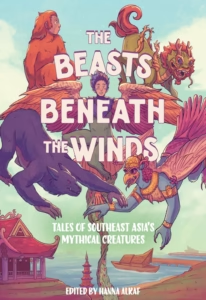The Beasts Beneath the Wind: Tales of Southeast Asia’s Mythical Creatures
edited by Hanna Alkaf
Harry N. Abrams
Published October 21, 2025
Amazon | Bookshop | Goodreads
About The Beasts Beneath the Wind
A sweeping and magical story collection showcasing the mythical creatures of Southeast Asia, including work by two-time Newbery medalist Erin Entrada Kelly and National Book Award finalist Shing Yin Khor
A turtle the size of an island. A cricket that can possess you if swallowed. A giant who turns enemies to stone. The legends of Southeast Asia—or “the lands below the winds,” as explorers used to call it—are populated with a whole menagerie of colorful beasts that inspire awe and fear in equal measure. Yet, passed on as they are through story and song, so many of these stories remain rooted in some long-forgotten past and bound by the borders of the region, creatures of myth and memory and nothing more. Until now.
Welcome to The Beasts Beneath the Winds, a collection of Southeast Asia’s most elusive cryptids by a team of bestselling and award-winning authors. Within these gorgeously illustrated pages, readers will find the stories of seventeen regular kids who encounter these mythical creatures in the here and now, and—fortunately or unfortunately—live to tell the tale.
My Review
I love how upbeat the tone of this whole collection is. Between each story, a two page spread that looks like pages from a journal introduces a cryptid. Illustrations show what the creature looks like while text describes where it lives, its temperament, and what it’s known for.
The stories often center around family relationships and connecting or reconnecting with the protagonist’s culture. Some stories are set in Southeast Asian countries while others happen in the United States. Sometimes the main character learns something unexpected about a friend or relative through their experience with the cryptid. At other times, the beast appears to impart wisdom or simply remind the protagonist that the world is a larger, more mysterious place than they realized.
I also love that this book introduces Southeast Asian mythology to readers in the context of short stories. This would be a perfect book to begin with for readers interested in folklore but who don’t generally reach for nonfiction. A list of further reading recommendations would have been amazing to add.
All in all, this is an entertaining collection that’s sure to engage readers.
Content Notes
Recommended for Ages 8 to12.
Profanity/Crude Language Content
None.
Romance/Sexual Content
None.
Spiritual Content
Contains stories about mythological beasts from Southeast Asian folklore and myths. Reference to Muslim holidays and prayer practices.
Violent Content
Situations of peril. In one story, characters stop poachers. In another, a character intervenes to help a creature battling an evil being.
Drug Content
None.
Note: This post contains affiliate links, which do not cost you anything to use but help support this blog. I received a free copy of this book in exchange for my honest review. All opinions are my own.
Marvelous Middle-Grade Monday
I’m sharing this post as a part of a weekly round-up of middle-grade posts called Marvelous Middle-Grade Monday. Check out other blogs with posts about middle-grade books today on Marvelous Middle-Grade Mondays at Always in the Middle.
